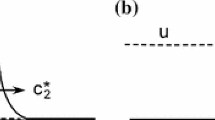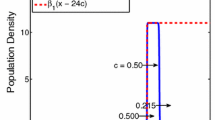Abstract
New models for seed dispersal and competition between plant species are formulated and analyzed. The models are integrodifference equations, discrete in time and continuous in space, and have applications to annual and perennial species. The spread or invasion of a single plant species into a geographic region is investigated by studying the travelling wave solutions of these equations. Travelling wave solutions are shown to exist in the single-species models and are compared numerically. The asymptotic wave speed is calculated for various parameter values. The single-species integrodifference equations are extended to a model for two competing annual plants. Competition in the two-species model is based on a difference equation model developed by Pakes and Maller [26]. The two-species model with competition and dispersal yields a system of integrodifference equations. The effects of competition on the travelling wave solutions of invading plant species is investigated numerically.
Similar content being viewed by others
References
Adee, S. R., Wender, W. F., Hartnett, D. C.: Competition between Pyrenophora triticirepentis and Septoria nodorum in the wheat leaf as measured with de Wit replacement series. Phytopathology 80, 1177–1182 (1990)
Allen, L. J. S., Allen, E. J., Kunst, C. R. G.: A diffusion model for dispersal of Opuntia imbricata (cholla) on rangeland. J. of Ecol. 79, 1123–1135 (1991)
Andersen, M.: Properties of some density-dependent integrodifference equation population models. Math. Biosci. 104, 135–157 (1991)
Andow, D. A., Kareiva, P. M., Levin, S. A., Okubo, A.: Spread of invading organisms. Landscape Ecology 4, 177–188 (1990)
Bannister, P.: Introduction to Physiological Plant Ecology. New York: John Wiley & Sons 1978
Begon, M., Mortimer, M.: Population Ecology. Second Ed., Massachusetts: Sinauer Associates 1986
de Wit, C. T., van den Bergh, J. P.: Competition between herbage plants. Neth. J. Agric. Sci. 13, 212–221 (1965)
Fisher, R. A.: The wave of advance of advantages genes. Ann. Eugen. London. 7, 355–369 (1937)
Hardin, D. P., Tákač, P., Webb, G. F.: Dispersion population models discrete in time and continuous in space. J. Math. Biol. 28, 1–20 (1990)
Klinkhamer, P. G. L., de Jong, T. J., Metz, J. A. J., Val, J.: Life history tactics of annual organisms: The joint effects of dispersal and delayed germination. Theor. Popul. Biol. 32, 127–156 (1987)
Kot, M.: Discrete-time travelling waves: ecological examples. J. Math. Biol. 30, 413–436 (1992)
Kot, M., Schaffer, W. M.: Discrete-time growth-dispersal models. Math. Biosci. 80, 109–136 (1986)
Lacey, J. R., Olson., B. E.: Environmental and economic impacts of noxious range weeds. In: Noxious Range Weeds (James, L. F., Evans, J. O., Ralphs, M. H., Child, R. D., Eds.) 5–16, Boulder, Co.: Westview Press 1991
Levin, S. A., Cohen, D., Hastings, A.: Dispersal strategies in patchy environments. Theor. Popul. Biol. 26, 165–191 (1984)
Lui, R.: A nonlinear integral operator arising from a model in population genetics, I. Monotone initial data, SIAM J. Math. Anal. 13, 913–937 (1982)
Lui, R.: A nonlinear integral operator arising from a model in population genetics, II. Initial data with compact support. SIAM J. Math. Anal. 13, 938–953 (1982)
Lui, R.: Biological growth and spread modeled by systems of recursions. I. Mathematical theory, Math. Biosci. 93, 269–295 (1989)
Lui, R.: Biological growth and spread modeled by systems of recursions. II. Biological theory, Math. Biosci. 93, 297–312 (1989)
MacDonald, N.: Models of an annual plant population with a seedbank. J. Theor. Biol. 93, 643–653 (1981)
Mollison, D.: Spatial contact models for ecological and epidemic spread. J. R. Statist. Soc. B 39, 283–326 (1977)
Murray, J. D.: Mathematical Biology. Berlin, Heidelberg, New York: Springer-Verlag 1989
Okubo, A.: Diffusion and Ecological Problems: Mathematical Models. Berlin, Heidelberg, New York: Springer-Verlag 1980
Okubo, A., Maim, P. K., Williamson, M. H., Murray, J. D.: On the spatial spread of the grey squirrel in Britain. Proc. Roy. Soc. Lond. B 238, 113–125 (1989)
Pacala, S. W.: Neighborhood models of plant population dynamics. 2. Multi-species models of annuals. Theor. Popul. Biol. 29, 262–292 (1986a)
Pacala, S. W.: Neighborhood models of plant population dynamics. 4. Single-species and multispecies models of annuals with dormant seeds. Am. Natur. 128, 859–878 (1986b)
Pakes, A. G., Maller, R. A.: Mathematical Ecology of Plant Species Competition: A Class of Deterministic Models for Binary Mixtures of Plant Genotypes. Cambridge, New York: Cambridge University Press 1990
Ritland, K.: The joint evolution of seed dormancy and flowering time in annual plants living in variable environments. Theor. Popul. Biol. 24, 213–243 (1983)
Rossiter, R. C., Maller, R. A., Pakes, A. G.: A model of changes in the composition of binary mixtures of subterranean clover strains. Aust. J. Agric. Res. 36, 119–143 (1985)
Schoener, T. W.: Alternatives to Lotka-Volterra competition: models of intermediate complexity. Theor. Popul. Biol. 10, 309–333 (1976)
Skellam, J. G.: Random dispersal in theoretical populations. Biometrika 38, 196–218 (1951)
Templeton, A. R., Levin, D. A.: Evolutionary consequences of seed pools. Am. Natur. 114, 232–249 (1979)
Turkington, R., Aarssen, L. W.: Local-scale differentiation as a result of competitive interactions. In: Perspectives on Plant Population Ecology. (Dirzo, R., Sarukhan, J., Eds.), 107–127, Massachusetts: Sinauer Assoc., Inc. 1984
Venable, D. L., Brown, J. S.: The selective interactions of dispersal, dormancy, and seed size as adaptations for reducing risk in variable environments. Am. Natur. 131, 360–384 (1988)
Weinberger, H. F.: Long-time behavior of a class of biological models. SIAM J. Math. Anal. 13, 353–396 (1982)
Author information
Authors and Affiliations
Rights and permissions
About this article
Cite this article
Allen, E.J., Allen, L.J.S. & Gilliam, X. Dispersal and competition models for plants. J. Math. Biol. 34, 455–481 (1996). https://doi.org/10.1007/BF00167944
Received:
Revised:
Issue Date:
DOI: https://doi.org/10.1007/BF00167944




